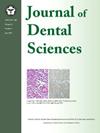Effect of pulp-chamber lateral wall thickness and number on fracture resistance in endocrown-restored molars: An in vitro study
IF 3.4
3区 医学
Q1 DENTISTRY, ORAL SURGERY & MEDICINE
引用次数: 0
Abstract
Background/purpose
It remains unclear how the thickness and number of pulp-chamber lateral walls (PCLWs) affects fracture resistance in endocrown-restored teeth.
Materials and methods
64 mandibular molars were collected and randomly divided into eight groups (n = 8). In group C (control group), the teeth were untreated. In groups T1, T2, and T3, the teeth were subjected to endodontic treatment and restored with nanoceramic endocrowns exhibiting different PCLW thicknesses (T1: 0.5 mm, T2: 1.0 mm, and T3: 1.5 mm). In groups N1, N2, N3, and N4, the numbers of missing PCLWs in prepared teeth were one (N1), two (N2), three (N3), and four (N4). All restored teeth were subjected to axial loading until fracture using a universal testing machine. The mean fracture loads were recorded and compared by one-way analysis of variance; the fractured samples were observed under a stereo microscope.
Results
The results showed no statistically significant differences in fracture load among groups T1, T2, and T3 (P > 0.05). Although the fracture loads gradually decreased as the number of missing PCLWs increased, there were no statistically significant differences in fracture load among groups C, N1, N2, and N3, and N4 (P > 0.05).
Conclusion
Both thickness and remaining number of PCLW does not affect fracture resistance in endodontically treated molars restored with nanoceramic endocrowns.
髓腔侧壁厚度和数量对冠内修复磨牙抗折性的影响体外研究
本文章由计算机程序翻译,如有差异,请以英文原文为准。
求助全文
约1分钟内获得全文
求助全文
来源期刊

Journal of Dental Sciences
医学-牙科与口腔外科
CiteScore
5.10
自引率
14.30%
发文量
348
审稿时长
6 days
期刊介绍:
he Journal of Dental Sciences (JDS), published quarterly, is the official and open access publication of the Association for Dental Sciences of the Republic of China (ADS-ROC). The precedent journal of the JDS is the Chinese Dental Journal (CDJ) which had already been covered by MEDLINE in 1988. As the CDJ continued to prove its importance in the region, the ADS-ROC decided to move to the international community by publishing an English journal. Hence, the birth of the JDS in 2006. The JDS is indexed in the SCI Expanded since 2008. It is also indexed in Scopus, and EMCare, ScienceDirect, SIIC Data Bases.
The topics covered by the JDS include all fields of basic and clinical dentistry. Some manuscripts focusing on the study of certain endemic diseases such as dental caries and periodontal diseases in particular regions of any country as well as oral pre-cancers, oral cancers, and oral submucous fibrosis related to betel nut chewing habit are also considered for publication. Besides, the JDS also publishes articles about the efficacy of a new treatment modality on oral verrucous hyperplasia or early oral squamous cell carcinoma.
 求助内容:
求助内容: 应助结果提醒方式:
应助结果提醒方式:


